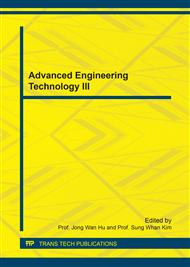p.423
p.429
p.434
p.442
p.450
p.457
p.463
p.468
p.474
An Increase in Accuracy of Robotic Milling
Abstract:
The results of the theoretical research and the computer simulation, aimed at increase in accuracy of robotic milling, are presented in the article. An analysis of the mathematical models of the system «technological robot – milling process» is conducted. The prospects of the usage of precision geared dual motor servo drives and trajectory-impedance control systems are underlined. A computer research of the tool movement accuracy during the robotic cylindrical up-milling process, depending on path velocity of the milling cutter and rated value of the cutting depth, has been carried out. Two types of manipulators have been considered: a manipulator with traditional geared servo drives with one motor and a manipulator with the suggested precision dual motor drives. In order to measure accuracy of movements during the computer simulation process a deviation of the tool, normal to the desired trajectory of its movement, has been defined. The results testify the facts that dual motor servo drives allow us to significantly increase dynamic stiffness of technological robots and they promote increasing accuracy and performance of robotic milling.
Info:
Periodical:
Pages:
450-456
Citation:
Online since:
June 2017
Authors:
Price:
Сopyright:
© 2017 Trans Tech Publications Ltd. All Rights Reserved
Share:
Citation:


